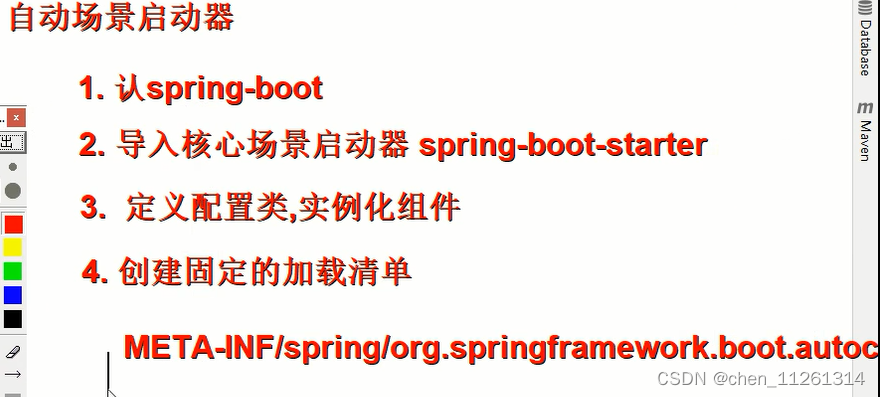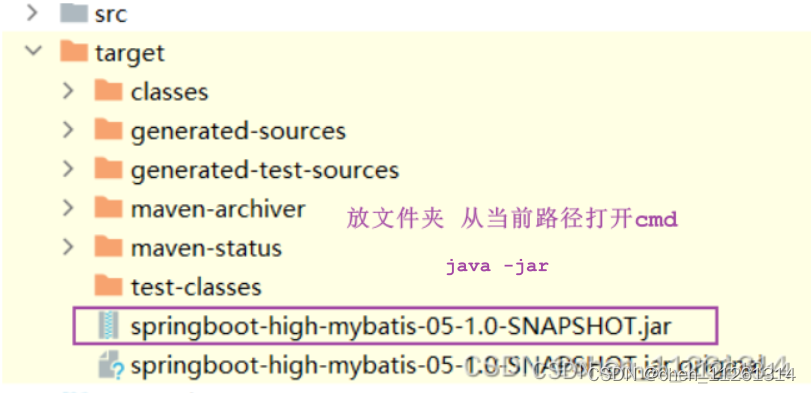1.SpringBoot概述:
-
springboot介绍
- 基于SpringFramework一个快速整合和配置框架
- 快速的创建一个Spring工程
- 内置服务器软件
- 提供了多种场景启动器,快速引入场景需要的依赖
- 提供了写好的配置类,并且提供了按需加载
- 提供了生产级别的程序监控附带程序
- 没有xml文件配置
- 约定俗成,约定大于配置程序的很多参数赋予默认配置值
-
springboot快速入门案例
- 主要步骤
- 创建maven工程
- 认springboot作为父工程
- 导入场景启动器
- 创建程序的主启动类
- 创建controller
- 启动程序即可
- 主要步骤
b.创建maven工程
c.添加依赖
<!-- 所有springboot项目都必须继承自 spring-boot-starter-parent -->
<parent>
<groupId>org.springframework.boot</groupId>
<artifactId>spring-boot-starter-parent</artifactId>
<version>3.0.5</version>
</parent>
<dependencies>
<!-- web开发的场景启动器 -->
<dependency>
<groupId>org.springframework.boot</groupId>
<artifactId>spring-boot-starter-web</artifactId>
</dependency>
</dependencies>
d.编写启动类
//是一个springboot的启动程序
@SpringBootApplication
public class Main {
public static void main(String[] args) {
//启动tomcat (创建ioc容器)
SpringApplication.run(Main.class,args);
}
}
e.添加controller
@RestController
@RequestMapping("boot")
public class HelloController {
@GetMapping("hello")
public String sayHello(){
System.out.println("HelloController.sayHello");
return "hello spring boot!!!";
}
}
- 前期体验优势
- 简化整合: 对应场景启动器包含当前场景需要的所有依赖和配置类
- 简化配置(IoC): 自动加载配置类,将核心组件加入ioc容器
- 统一配置: 统一配置管理,集中方便配置
- 依赖管理机制理解
- 为什么导入starter-web(web场景启动器)所有相关依赖都导入进来?
- 为什么版本号都不用写?
- spring-boot-parent -> spring-boot-dependecies 声明完毕了
- 如何自定义版本号?
- 依赖的时候version
- 声明propertites属性覆盖
- 第三方依赖导入,父工程没有指定版本号如何处理?
- 自己声明version
二.SpringBoot统一配置管理:
- 统一配置管理机制
- 概述
- 约定配置参数写到固定的配置文件中
- 不需要指定加载,可以直接使用
- 配置文件内容分类
- 自定义配置,key随意定义,建议多层命名
- 其他启动器配置,key是固定的
- 概述
-
- 配置文件规则
- 命名: application*
- 位置: resources文件夹下即可 **/application*.yml | yaml | properties
- 格式: properties | yaml , yml
- 配置文件规则
- 属性配置文件和读取
- 缺点: 每次key全要自己写
- 优点: 清晰展示
- YAML配置文件和读取
- 优点: key可以靠缩进,进行多层简化
- 缺点:展示效果一般
- 批量配置文件读取
- 定义接收参数的组件
- 类上添加批量读取注解
- 确保属性名等于参数的最后一层key
@ConfigurationProperties(prefix = "my.data.user")
@Data
@Component
public class MyProperties {
//@Value("${my.data.user.name}")
private String name;
//@Value("${my.data.user.age}")
private int age;
}
my:
data:
user:
age: 18
name: xioamiong 5.多环境profile配置和切换
- 声明分出去的配置
- 命名: application-{被激活的名}.yml | properties
2. 主配置中激活分配置
# 激活其他的配置文件
# 其他配置文件命名: application-{激活的文件名}.yaml
# 如果: 被激活文件和主配资参数重复,被激活优先!!!
spring:
profiles:
active: my,my1
三.SpringBoot自动配置原理
/**
* TODO: springBoot的启动类,都会添加@SpringBootApplication注解
* @SpringBootApplication
* 作用1: @SpringBootConfiguration -> @Configuration -> 启动类就是配置类
* 作用2: @ComponentScan(没有定义包) 如果不定义包,默认扫描配置类所在的包和后代包!
* 作用3: @EnableAutoConfiguration 完成springboot自动化配置的!
*
* 1. 为什么我们自定义的组件类,放在启动类的相同包或者子包就会被扫描?
* 答: @SpringBootApplication -> @ComponentScan -> 没有指定包,默认指定启动类所在的包或者后代包
* 扩展: 如果[想修改默认]扫描的包,需要设置属性@SpringBootApplication(scanBasePackages="包") [了解]
*
* 2. ioc容器是在什么时候创建的?
* 答: 启动类 -> main -> SpringApplication.run(Main.class,args); -> ioc容器 | 启动tomcat
*
* 3. springboot是如何完成自动配置类加载? [面试题]
*
* 3.1 理解谁帮我们写的配置类?
* 官方场景启动器需要的配置类: spring-boot
* 第三方的场景启动需要的配置: 第三方自己定义
* 3.2 配置类存储到什么位置了?
* 所有的场景启动器都需要依赖一个[核心启动:boot工程启动的必备条件] spring-boot-starter
* spring-boot-starter / spring-boot-starter-autoconfigure -> 配置类
* 真实包: xxxxAutoConfiguration [142个配置类] 可能存在的组件数量 142 * 10 = 1420个
* 清单内容: META-INF/spring/org.springframework.boot.autoconfigure.AutoConfiguration.imports
* org.springframework.boot.autoconfigure.admin.SpringApplicationAdminJmxAutoConfiguration
* org.springframework.boot.autoconfigure.aop.AopAutoConfiguration
* org.springframework.boot.autoconfigure.amqp.RabbitAutoConfiguration
* 3.3 为什么不会直接加载所有配置类的组件?
* 理解: 我们不需要所有的配置类,应该按需加载配置
* 例如: 只有我导入了mq的包,才应该给我创建mq相关的组件,对应的配置类才应该生效!!
* 解释: spring / ioc / 注解 / @Conditional [条件化注入] + @Bean [spring 4.0新特性]
* 142个配置类,谁都会添加@Conditional注解!!!
* @ConditionalOnClass(Gson.class)
* 实现: 按需加载
* 问题: 不要瞎导入场景启动器!一旦导入了配置类就生效了! 配置类需要外部配置参数支撑,你没写配置参数!
*
* 3.4 springboot如何完成自动化配置加载(如何加载的这些配置类)?
* 如何加载多个配置类:
* 方案1: 创建ioc容器的时候,指定多个配置类 容器(配置类1.class,配置类2.class...)
* 方案2: 在一个配置类上,@Import({其他配置类.class,其他配置类.class}),同时多个配置类生效
* 方案3: 批量配置类导入, @Import(importSelector) -> 配置类的全限定符添加到对应的方法的数组中即可
* 自动化配置方式: @SpringBootApplication -> @EnableAutoConfiguration -> @Import(142配置类) 不是
*
* 真正的自动导入: @SpringBootApplication -> @EnableAutoConfiguration -> @Import(AutoConfigurationImportSelector.class)
* AutoConfigurationImportSelector.class -> String[] selectImports ->
* 配置类的清单文件中,找到所有配置类的全限定符即可
* [META-INF/spring/org.springframework.boot.autoconfigure.AutoConfiguration.imports]
*
* @Conditional @Import + ImportSelector -> 清单内容
*
* 4. 场景启动的配置参数是如何读取的?
*
* server.port = 8888 -> 端口 -> 配置类的参数 [固定读取server.port = key]
* 配置类固定读取对应的key,只要修改就可以改变配置类的参数!!!
*
* 自动 == 固定
*
*/
四.Spring自定义启动器

1.自定义启动器场景
1.封装通用功能模块:当你在多个项目中使用相同的功能模块时,可以考虑创建自定义启动器来封装这些通用功能。
通过自定义启动器,你可以将相关的依赖项、配置和自动化初始化代码打包在一起,使得在不同项目中使用该功能变得简单和一致。
2.解耦复杂的依赖关系:有时候,一个功能模块可能依赖于多个复杂的第三方库或组件。为了简化使用这种功能模块的流程,
你可以创建一个自定义启动器,将这些复杂的依赖项和配置进行封装和管理,而使用者只需引入自定义启动器,
而无需直接处理这些复杂的依赖关系。
2.自定义启动器需求
场景:
自动
加载指定的配置类
3.自定义启动器流程
1.创建启动器项目
2.引入启动器依赖
<parent>
<groupId>org.springframework.boot</groupId>
<artifactId>spring-boot-starter-parent</artifactId>
<version>3.0.5</version>
</parent>
<groupId>com.atguigu</groupId>
<artifactId>springboot-hight-mybatis-starter-03</artifactId>
<version>1.0-SNAPSHOT</version>
<properties>
<maven.compiler.source>17</maven.compiler.source>
<maven.compiler.target>17</maven.compiler.target>
<project.build.sourceEncoding>UTF-8</project.build.sourceEncoding>
</properties>
<dependencies>
<dependency>
<groupId>org.springframework.boot</groupId>
<artifactId>spring-boot-starter</artifactId>
</dependency>
<dependency>
<groupId>org.projectlombok</groupId>
<artifactId>lombok</artifactId>
</dependency>
</dependencies>
3.准备组件类
@Data
public class SqlSessionFactoryBean {
private String info;
}
4.准备配置类
@ComponentScan
@Configuration
public class MyBatisAutoConfiguration {
@Autowired
private MybatisProperties properties;
@Bean
public SqlSessionFactoryBean sqlSessionFactoryBean(){
SqlSessionFactoryBean sqlSessionFactoryBean = new SqlSessionFactoryBean();
System.out.println(properties.getAccount() + "||" + properties.getPassword());
sqlSessionFactoryBean.setInfo(properties.getAccount() + "||" + properties.getPassword());
return sqlSessionFactoryBean;
}
}
5.编写自动配置
META-INF/spring/org.springframework.boot.autoconfigure.AutoConfiguration.imports 文件中编写好我们自动配置类的全类名即可
com.atguigu.config.MyBatisAutoConfiguration
6.使用自定义启动器
其他boot工程导入依赖即可
<dependency>
<groupId>com.atguigu</groupId>
<artifactId>springboot-hight-mybatis-starter-03</artifactId>
<version>1.0-SNAPSHOT</version>
</dependency>
五.SpringBoot整合MyBatis
实现步骤:
1. 导入对应的场景启动器和依赖(web,mybatis,jdbc,lombok)
2. 定义mapper接口和mapperxml文件
3. 启动的配置类上添加@MapperScanner("包")
mybatis必须得配置:
spring:
datasource:
url: jdbc:mysql://localhost:3306/day01
driver-class-name: com.mysql.cj.jdbc.Driver
username: root
password: root
type: com.zaxxer.hikari.HikariDataSource
# 可选的配置 别名 日志 xxx
mybatis:
type-aliases-package: com.atguigu.pojo
mapper-locations: classpath:mappers/*.xml
configuration:
map-underscore-to-camel-case: true
auto-mapping-behavior: full
log-impl: org.apache.ibatis.logging.slf4j.Slf4jImpl
声明事务实现: @Transactional
1. 导入事务的场景启动器 jdbc
2. 直接使用注解 @Transactional
AOP的实现配置:
1. 导入aop的场景启动器 aop
2. 自己写切面即可
1.导入依赖
<parent>
<groupId>org.springframework.boot</groupId>
<artifactId>spring-boot-starter-parent</artifactId>
<version>3.0.5</version>
</parent>
<dependencies>
<dependency>
<groupId>org.springframework.boot</groupId>
<artifactId>spring-boot-starter-web</artifactId>
</dependency>
<dependency>
<groupId>org.mybatis.spring.boot</groupId>
<artifactId>mybatis-spring-boot-starter</artifactId>
<version>3.0.1</version>
</dependency>
<!-- 数据库相关配置启动器 -->
<dependency>
<groupId>org.springframework.boot</groupId>
<artifactId>spring-boot-starter-jdbc</artifactId>
</dependency>
<!-- 驱动类-->
<dependency>
<groupId>mysql</groupId>
<artifactId>mysql-connector-java</artifactId>
<version>8.0.28</version>
</dependency>
<dependency>
<groupId>org.projectlombok</groupId>
<artifactId>lombok</artifactId>
<version>1.18.28</version>
</dependency>
</dependencies>
2.配置文件
application.properties
server:
port: 8001
spring:
datasource:
url: jdbc:mysql://localhost:3306/数据库名
driver-class-name: com.mysql.cj.jdbc.Driver
username: root
password: 123456
type: com.zaxxer.hikari.HikariDataSource
jackson:
date-format: yyyy-MM-dd HH:mm:ss
time-zone: GMT+8
#映射
mybatis:
#是告诉 MyBatis 在类路径下的 /mappers/ 目录中查找所有以 .xml 结尾的文件,并将它们作为 SQL 映
射文件加载到 MyBatis 中。
mapper-locations: classpath:/mappers/*.xml
#类名映射 配置文件类名可小写
type-aliases-package: com.atguigu.pojo
configuration:
#将数据库字段的下划线命名转换为驼峰命名规则
map-underscore-to-camel-case: true
#将数据库查询结果映射到 Java 对象
auto-mapping-behavior: full
log-impl: org.apache.ibatis.logging.slf4j.Slf4jImpl
#分页方言
pagehelper:
helper-dialect: mysql
3.实体类准备
package com.atguigu.pojo;
@Data
public class User {
private String account ;
private String password ;
private Integer id ;
4.Mapper接口准备
public interface UserMapper {
List<User> queryAll();
}
5.MapperXML文件准备
<?xml version="1.0" encoding="UTF-8" ?>
<!DOCTYPE mapper
PUBLIC "-//mybatis.org//DTD Mapper 3.0//EN"
"https://mybatis.org/dtd/mybatis-3-mapper.dtd">
<!-- namespace = 接口的全限定符 -->
<mapper namespace="com.atguigu.mapper.UserMapper">
<select id="queryAll" resultType="user">
select * from users
</select>
</mapper>
6.启动类配置
@MapperScan("com.atguigu.mapper") //mapper接口扫描配置
@SpringBootApplication
public class MainApplication {
public static void main(String[] args) {
SpringApplication.run(MainApplication.class,args);
}
}
六.SpringBoot整合SpringMVC
实现步骤:
1. maven-> boot工程
2. 导入场景启动器 (spring-boot-starter-web)
3. 创建Controller实现接口 [json处理能力]
web场景启动器对应的配置:
port:
根路径:
server:
port: 8888
servlet:
context-path: /
静态资源问题:
ssm -> mvc:default-servlet-handler (二秘书)
外部访问的时候不需要写static文件夹名
spring:
web:
resources:
static-locations: classpath:/webapp/
springboot -> 约定俗称 -> 约定大于配置 -> "classpath:/META-INF/resources/", "classpath:/resources/", "classpath:/static/", "classpath:/public/"
拦截器配置:
ssm -> 定义一个拦截器的实现类 -> xml -> <mvc:interceptors 标签
boot -> 定义一个拦截器的实现类 -> 定义一个标准的配置类 -> 配置类中声明拦截器即可
1. 定义拦截器
2. 定义一个springmvc配置类 [提供了各个方向的配置方法] public class SpringMVCConfiguration implements WebMvcConfigurer
3. 重写添加拦截器的方法,完成添加即可
@Autowired
private MyInterceptor myInterceptor;
@Override
public void addInterceptors(InterceptorRegistry registry) {
//拦截器 加入到 registry 参数中!
registry.addInterceptor(myInterceptor).addPathPatterns("/**","/user/**")
.excludePathPatterns("/user/aaa")
.order(10);
}
1.导入依赖
<?xml version="1.0" encoding="UTF-8"?>
<project xmlns="http://maven.apache.org/POM/4.0.0"
xmlns:xsi="http://www.w3.org/2001/XMLSchema-instance"
xsi:schemaLocation="http://maven.apache.org/POM/4.0.0 http://maven.apache.org/xsd/maven-4.0.0.xsd">
<modelVersion>4.0.0</modelVersion>
<parent>
<groupId>org.springframework.boot</groupId>
<artifactId>spring-boot-starter-parent</artifactId>
<version>3.0.5</version>
</parent>
<groupId>com.atguigu</groupId>
<artifactId>springboot-starter-springmvc-03</artifactId>
<version>1.0-SNAPSHOT</version>
<properties>
<maven.compiler.source>17</maven.compiler.source>
<maven.compiler.target>17</maven.compiler.target>
<project.build.sourceEncoding>UTF-8</project.build.sourceEncoding>
</properties>
<dependencies>
<!-- web开发的场景启动器 -->
<dependency>
<groupId>org.springframework.boot</groupId>
<artifactId>spring-boot-starter-web</artifactId>
</dependency>
</dependencies>
</project>
2.启动配置类
@SpringBootApplication
public class MainApplication {
public static void main(String[] args) {
SpringApplication.run(MainApplication.class,args);
}
}
3.实体类准备
package com.atguigu.pojo;
@Data
public class User {
private String username ;
private String password ;
private Integer age ;
private String sex ;
4.controller编写
package com.atguigu.controller;
import com.atguigu.pojo.User;
import org.springframework.stereotype.Controller;
import org.springframework.web.bind.annotation.GetMapping;
import org.springframework.web.bind.annotation.RequestMapping;
import org.springframework.web.bind.annotation.ResponseBody;
@Controller
@RequestMapping("/user")
public class UserController {
@GetMapping("/getUser")
@ResponseBody
public User getUser(){
User user = new User();
user.setUsername("杨过");
user.setPassword("123456");
user.setAge(18);
user.setSex("男");
return user;
}
}
5.web相关配置
# web相关的配置
# https://docs.spring.io/spring-boot/docs/current/reference/html/application-properties.html#appendix.application-properties.server
server:
# 端口号设置
port: 80
# 项目根路径
servlet:
context-path: /boot6.静态资源处理
# web相关的配置
# https://docs.spring.io/spring-boot/docs/current/reference/html/application-properties.html#appendix.application-properties.server
server:
# 端口号设置
port: 80
# 项目根路径
servlet:
context-path: /boot
spring:
web:
resources:
# 配置静态资源地址,如果设置,会覆盖默认值
static-locations: classpath:/webapp
7.拦截器定义
1.定义拦截器
package com.atguigu.interceptor;
import jakarta.servlet.http.HttpServletRequest;
import jakarta.servlet.http.HttpServletResponse;
import org.springframework.stereotype.Component;
import org.springframework.web.servlet.HandlerInterceptor;
import org.springframework.web.servlet.ModelAndView;
@Component
public class MyInterceptor implements HandlerInterceptor {
@Override
public boolean preHandle(HttpServletRequest request, HttpServletResponse response, Object handler) throws Exception {
System.out.println("MyInterceptor拦截器的preHandle方法执行....");
return true;
}
@Override
public void postHandle(HttpServletRequest request, HttpServletResponse response, Object handler, ModelAndView modelAndView) throws Exception {
System.out.println("MyInterceptor拦截器的postHandle方法执行....");
}
@Override
public void afterCompletion(HttpServletRequest request, HttpServletResponse response, Object handler, Exception ex) throws Exception {
System.out.println("MyInterceptor拦截器的afterCompletion方法执行....");
}
}
2.声明拦截器
package com.atguigu.config;
import com.atguigu.interceptor.MyInterceptor;
import org.springframework.beans.factory.annotation.Autowired;
import org.springframework.context.annotation.Configuration;
import org.springframework.web.servlet.config.annotation.InterceptorRegistry;
import org.springframework.web.servlet.config.annotation.WebMvcConfigurer;
@Configuration
public class MvcConfig implements WebMvcConfigurer {
@Autowired
private MyInterceptor myInterceptor ;
/**
* /** 拦截当前目录及子目录下的所有路径 /user/** /user/findAll /user/order/findAll
* /* 拦截当前目录下的以及子路径 /user/* /user/findAll
* @param registry
*/
@Override
public void addInterceptors(InterceptorRegistry registry) {
registry.addInterceptor(myInterceptor).addPathPatterns("/**");
}
}
七.SpringBoot 整合AOP和TX
1.声明式事务
1.导入依赖
<dependency>
<groupId>org.springframework.boot</groupId>
<artifactId>spring-boot-starter-jdbc</artifactId>
</dependency>
2.使用注解
@Transactional
public void update(){
User user = new User();
user.setId(1);
user.setPassword("test2");
user.setAccount("test2");
userMapper.update(user);
}
2.Aop 的声明配置
1.导入依赖
<dependency>
<groupId>org.springframework.boot</groupId>
<artifactId>spring-boot-starter-aop</artifactId>
</dependency>
2.aop切面配置
@Component
@Aspect
public class LogAdvice {
@Before("execution(* com..service.*.*(..))")
public void before(JoinPoint joinPoint){
System.out.println("LogAdvice.before");
System.out.println("joinPoint = " + joinPoint);
}
}
九.项目打包运行
1.添加插件
<!-- SpringBoot应用打包插件-->
<build>
<plugins>
<plugin>
<groupId>org.springframework.boot</groupId>
<artifactId>spring-boot-maven-plugin</artifactId>
</plugin>
</plugins>
</build>
2.启动命令和参数


























 被折叠的 条评论
为什么被折叠?
被折叠的 条评论
为什么被折叠?








